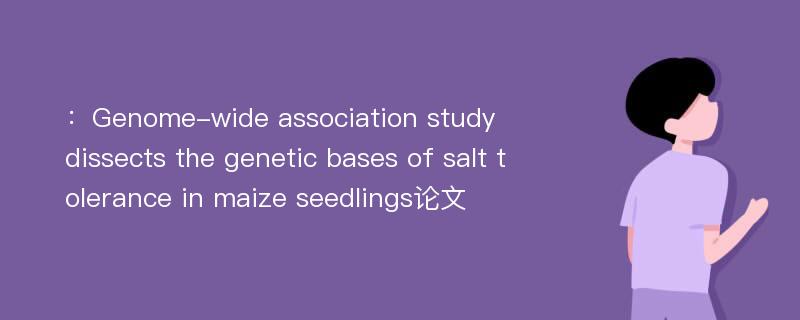
本文主要研究内容
作者(2019)在《Genome-wide association study dissects the genetic bases of salt tolerance in maize seedlings》一文中研究指出:Excess salinity is a natural stress that causes crop yield losses worldwide. The genetic bases of maize salt tolerance remain largely unknown. Here we investigated the survival rates of 445 maize natural accessions after salt treatments. A skewed distribution of the salttolerant phenotypes was observed in this population.Genome-wide association studies(GWAS) revealed 57 loci significantly associated with salt tolerance. Forty-nine candidate genes were detected from these loci. About10% of these genes were co-localized with loci from QTL mapping. Forty four percent of the candidate genes were involved in stress responses, ABA signaling,stomata division, DNA binding/transcription regulation and auxin signaling, suggesting that they are key genetic mechanisms of maize salt tolerance. Transgenic studies showed that two genes, the salt-tolerance-associatedgene 4(SAG4, GRMZM2 G077295) and SAG6(GRMZM2 G106056), which encode a protein transport protein and the double-strand break repair protein MRE11,respectively, had positive roles in plant salt tolerance,and their salt-tolerant haplotypes were revealed. The genes we identified in this study provide a list of candidate targets for further study of maize salt tolerance, and of genetic markers and materials that may be used for breeding salt-tolerance in maize.
Abstract
Excess salinity is a natural stress that causes crop yield losses worldwide. The genetic bases of maize salt tolerance remain largely unknown. Here we investigated the survival rates of 445 maize natural accessions after salt treatments. A skewed distribution of the salttolerant phenotypes was observed in this population.Genome-wide association studies(GWAS) revealed 57 loci significantly associated with salt tolerance. Forty-nine candidate genes were detected from these loci. About10% of these genes were co-localized with loci from QTL mapping. Forty four percent of the candidate genes were involved in stress responses, ABA signaling,stomata division, DNA binding/transcription regulation and auxin signaling, suggesting that they are key genetic mechanisms of maize salt tolerance. Transgenic studies showed that two genes, the salt-tolerance-associatedgene 4(SAG4, GRMZM2 G077295) and SAG6(GRMZM2 G106056), which encode a protein transport protein and the double-strand break repair protein MRE11,respectively, had positive roles in plant salt tolerance,and their salt-tolerant haplotypes were revealed. The genes we identified in this study provide a list of candidate targets for further study of maize salt tolerance, and of genetic markers and materials that may be used for breeding salt-tolerance in maize.
论文参考文献
论文详细介绍
论文作者分别是来自Journal of Integrative Plant Biology的,发表于刊物Journal of Integrative Plant Biology2019年06期论文,是一篇关于,Journal of Integrative Plant Biology2019年06期论文的文章。本文可供学术参考使用,各位学者可以免费参考阅读下载,文章观点不代表本站观点,资料来自Journal of Integrative Plant Biology2019年06期论文网站,若本站收录的文献无意侵犯了您的著作版权,请联系我们删除。
